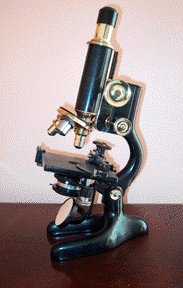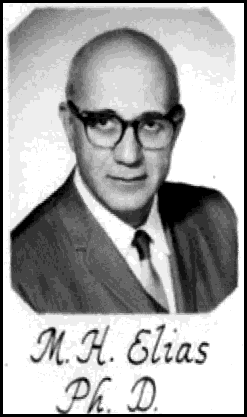Paraphernalia
Michael Ingall, M. D.
The Microscope

In 1962, I found myself in medical school in Chicago, almost 40 years after my father had bought it. I was a native-born American, but still without much money, as my father was better at being adored by patients than at earning money from them. So, I took the old Bausch & Lomb with me, now tired, scratched, and tarnished, but still with decent optics and a smooth gear action.
I was terrified when I began medical school. I had been an excellent student in high school and could hold my own with the best brains that Newton High had to offer. But at Harvard, everyone was a boy wonder, and I fell behind. There was more to it than that. I was determined not to go Harvard like my father, not to be a doctor like my father, not to die at 55 like my father. I wasn't really aware of my unconscious at the time. I didn't know I had an unconscious. I just thought I was a fuck-off with a penchant for flunking pre-med courses.
But despite my worst efforts, I found myself at the Chicago Medical School, just because I didn't know what else to do. And, while I quickly realized that I was as smart as anyone else in the class, it soon became clear to me that I wasn't as determined or ruthless as my classmates.
In histology class, we sat at long tables and unpacked our microscopes. I took my dingy Bausch and Lomb monocular out of its original wooden box. One row ahead of me, George Greenberg, huffing and puffing through his fat red cheeks, opened his leather case to proudly display his brand-new Leitz binocular zoom.
I looked around the room. Every single person had a new binocular scope, most of them with zoom. And here was I, son of Anton van Leewenhoek, with his 19th Century monocular. My hands shook as I mounted a slide of stained liver onto my platform. Clearly, I was out of my league. Certainly, I lacked the right stuff. Surely, I was going to flunk out.
The professor was Hans Elias. Dr. Elias was a Viennese histologist who was world famous for his ability to conceptualize and draw the liver in three dimensions. But to the class he was known as "Hansie," for the voice of his wife and laboratory partner, calling him into their private lab. Hansie made it a point to tell us that he never used deodorant because the scent of a male armpit drove women wild. He was also known to us as "Bullethead" for reasons that will be obvious when you look at his phallic-shaved head.
 Dr. Elias strolled about the room, passing through the lab tables, as we all pretended we could make heads or tails out of the purple blur under the lens. He stopped behind my chair, and declaimed in a booming voice: "Chentelmen!! Who hass zee finest microzcope in zee clahss?"
Dr. Elias strolled about the room, passing through the lab tables, as we all pretended we could make heads or tails out of the purple blur under the lens. He stopped behind my chair, and declaimed in a booming voice: "Chentelmen!! Who hass zee finest microzcope in zee clahss?"
Sweat poured off my brow as I continued to peer through the old microscope, pretending that he had not found me out to be the dolt that I was. George Greenberg prepared himself for his first step toward the Nobel Prize in Medicine.
"Chentelmen!! It iss ziss vun!" he exclaimed, pointing to my antique monocular. "Mit ziss vun, you can look viz bose eyes, vun sroo zee microzcope, und zee uzzer at vat you are drawing. Zose of you who haff zpent a fortune on your fency new microzcopes haff srown avay your money! Ziss iss all you need."
So, I would be a doctor after all, and not kill too many patients, I hoped.
I never used the microscope after the second year of medical school. A couple of the tadpoles in the gobs of goo became my children. And I got tired of squashing ants. So it sat on a shelf in my study, gathering dust and layers of tarnish.
This year, when we sold our house and moved to an apartment, the microscope was one of the few memorabilia that I kept. I took it to a brass refinisher and spent several hundred dollars, much more than my father paid, I'm sure, to have him take it apart and polish every knob and screw. Now it sits in our dining room, gleaming. It hasn't looked so good in 75 years. It still works very well, with a nice gear action and good optics. Perhaps my grandchildren will be curious.